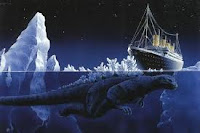
Designed by Graham Bartram, this is the most popular unofficial flag of Antarctica, symbolizing the continent's neutrality. Graham was a rather unimaginative child. When he played with sticks or string he was pretty much thinking of sticks or string. This submission narrowly beat out the only other offering, a flag depicting an emaciated Sir Ernest Shackleton eating a penguin.
The first memory I can recall of Antarctica was a Godzilla movie I saw as a child. In this feature the Japanese find him frozen in the ice. They carve away the area in which Godzilla is entombed and tow the massive ice chunk back to Japan for reasons which are never explained. A souvenir? A museum piece? International one-ups-man-ship? No matter. The ice melts as they proceed into tropic waters, freeing the ever-cranky hater of buildings large and small to do a little urban planning. The 70's rock group Blue Oyster Cult would later sing "History shows again and again how nature points up the folly of men. Godzilla!"
So it goes that misinformation about Antarctica starts early in life. Through the years I came to believe many of the same things everyone else believes about Antarctica:
1. There are no polar bears in Antarctica. That is what the name Antarctica translates to mean, "Without Polar Bears." I should have been suspicious of this one since I had only heard it from Alaskans. True enough, there are no bears in Antarctica, but the name Antarctica is the romanized version of the Greek compound word ανταρκτική meaning "opposite to the north".
2. It snows constantly in Antarctica. How do you think the whole thing became one big chunk of ice?!
Antarctica is considered a desert, with annual precipitation of only 200 mm (8 inches) along the coast and far less inland
3. Giant biped dinosaurs roam Antarctica hoping to one day pull down a set of high-tension powerlines.
Only cold-adapted plants and animals survive there, including penguins, seals, nematodes, tardigrades, mites, many types of algae and other microorganisms, and tundra vegetation.
4. Antarctica is the coldest place on earth.
This one is correct. About 98% of Antarctica is covered by ice, which averages at least 1 mile in thickness. Antarctica, on average, is the coldest, driest, and windiest continent. The coldest natural temperature ever recorded on Earth was −89.2 °C (−128.6 °F) at the Russian Vostok Station in Antarctica on 21 July 1983.[31] For comparison, this is 11 °C (20 °F) colder than subliming dry ice.
5. Antarctica is basically flat.
This is even more misguided than #3. Antarctica is home to the Ellsworth Mountain Range and the highest point on the continent, 16,048 foot Vinson Massif.
